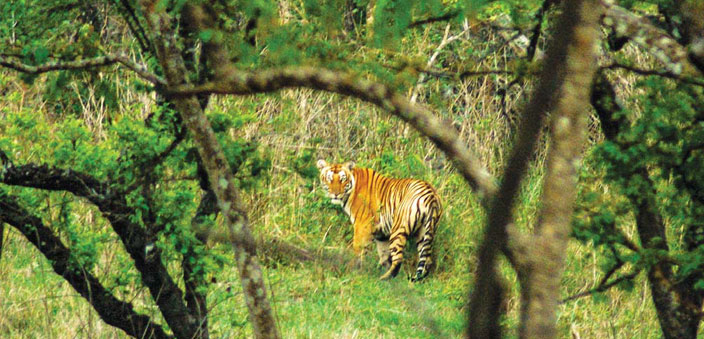Bandipur Tiger Reserve
There was a crispness in the air and as the early morning mist lifted, Bandipur Tiger Reserve seemed to awaken from its slumber. A symphony of bird calls greeted us even as our open safari vehicle glided down the dirt road – two tire-worn strips of brown that snaked through a forest. We stopped briefly to admire a serpent eagle that eyed us and our barrel-nosed cameras with disdain from its perch up in a tree.
A herd of spotted deer on the fringe of the safari trail looked up with concern. The rays of the morning sun filtered through the forest and spot lit a handsome stag, highlighting its liquid eyes and the velvet of its impressive antlers. Reassured that we were not predators, these gentle creatures – the popular fast-food of the wild in India – returned to their grazing.

Further down the road, a female sambar and its calf scurried into the thicket, the bristly hair on their muscled rumps glistening in the sunlight. Overhead, a Malabar giant squirrel was totally indifferent to our presence as it leapt through the branches with its bushy rust-red tail bobbing behind it like a rudder.
A troop of langurs leapt around while one mother suckled her baby; a red-crested woodpecker tapped away rhythmically on the trunk of a dead tree… all very nice for an average safari. But our pulse raced with anticipation as we negotiated each bend in the trail: would we be rewarded with the prized sighting of the Indian safari trail?


“Tiger!” our driver-guide whispered; his voice hoarse with excitement. We could not believe our luck, for there, in a clearing, sat the majestic beast. So often we have been on game drives in parks and reserves across the country hoping – willing – that a big cat would honour us with its presence and ended up disappointed. We do not blame the forest guides for not trying hard enough. In fact they are focused, almost to the exclusion of all else, on tracking the king of the Indian jungles. They read pug marks to determine if the cat is male or female, the time of day or night when it prowled down the path, the direction it was headed. Tiger droppings or spoor reveal if the big cat has feasted on a fresh or old kill…
More often than not, we had to settle for just knowing that the predator was close by, but out of sight, loping through his domain, unchallenged by all the other animals who deign to call it home. Not this time though: we had chanced upon the real thing. True, the striped cat was some distance away but that did not make him less imposing. He glared back at us with the air of one who knew he inspired fear in all who dared to cross his path. Then tiring of our pesky presence, he rose and strode off into the thicket; his long black and yellow striped tail waving farewell as he disappeared into the forest.

Elated by the prized sighting, we continued on a game drive that had more rewards further down the trail. The first was an elephant with its calf at a salt lick. The little one was curious but its mother was cautious and she positioned herself protectively between its ward and us. Seeing that we had no intention of moving on, she trumpeted her displeasure; a goosebumpy call that reverberated through the forest. Okay, we had got the message and were on our way once more.
‘The Serai’ experience
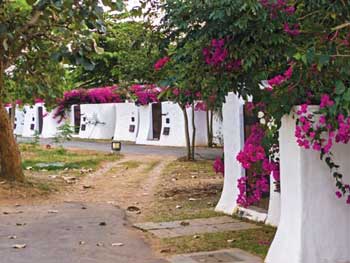
We encountered two more elephant herds which was not really surprising as the Nilgiri Biosphere which includes the national parks of Bandipur and Nagarahole in Karnataka, Mudumalai in Tamil Nadu and Wynaad in Kerala, has the largest concentration of Asiatic elephants in the world – 3,000 and counting. Back at The Serai Bandipur, and in-touch-with-nature wildlife resort that has the look and feel of luxury private game lodges in South Africa, we sat around a camp fire and shared our safari experience with other guests who congratulated us on our lucky tiger sighting. We ought to have been content: but no, we felt a twinge of denial when we found out that one of the other vehicles had chanced upon a pack of wild dogs that had brought down a spotted deer. Yes, a wildlife safari is like a gambling addiction: you are never satisfied even when you are winning.
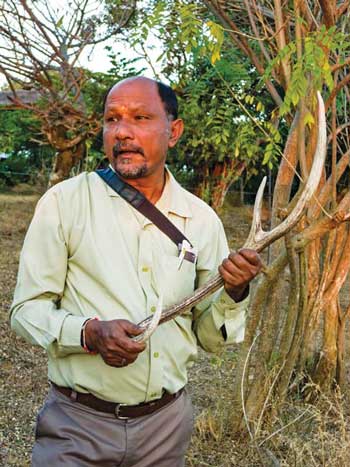
The Serai, however, was an outright winner all right. Snuggled in the foothills of the Nilgiris, it had a spectacular view of the forested slopes of the Blue Mountains that reflected the shifting moods of the day…and night. Indeed, there was romance in the air after sunset as the resort arranged intimate tables-for-two for couples celebrating special occasions. And as darkness claimed the sky and studded it with stars, nocturnal life started to stir in the forest surrounding the resort… some animals are prone to sneak quite close to the property. Early next morning, we set off on a bird watching tour with Kuttappan, the resort’s fabled naturalist who even has a species of insect that he discovered named after him. His keen eye, knowledge of the wild and powerful binoculars helped us zero in on a variety of feathered creatures: owls, woodpeckers, drongos, coppersmiths, red and yellow vented bulbuls… and a number of other brilliantly plumed birds whose exotic names we promptly forgot.
Suddenly, the silence of the morning was rent with the trumpet call of an elephant. Moments later, two behemoths herding a little calf between them emerged on a hillock no more than 50 metres from the trail we were on. According to Kuttappan, the elephants were either calling out to the main herd or warning other animals (and humans too) to steer clear of their path as they plodded down one of the many migration corridors between the national parks. Seeing these giants at such close quarters and without the safety of a safari vehicle made us feel vulnerable and, at the same time, privileged. We felt a sense of connect with these beasts that came from knowing that we were meeting them on equal terms; that they could have so easily charged and trampled us, yet chose not to.
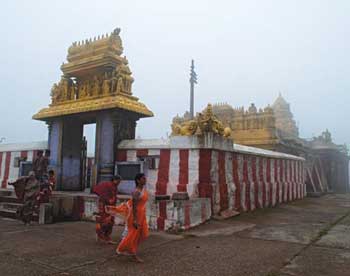

There were more elephants in the forest surrounding the 700-year-old hilltop Srihamawat Gopal Swamy Temple, some 12 km from the entrance of the Tiger Reserve. We, however, first imagined that they were large boulders scattered in the valley below… that was till they started to move and we noticed that they had trunks, tails, flapping ears!
On the drive back to the resort, our driver suddenly pulled up on the road just outside the resort. “Leopard,” he whispered. And sure enough, there it was; draped on the branches of a tree, some 25 metres away from us. The hoof of a deer sticking out at an awkward angle indicated that it had just enjoyed a hearty meal. Realizing that we were not going to leave in a hurry, it gave us a disgruntled snarl, leapt down from the tree and disappeared into the all-embracing forest.
It would be an understatement to say that our Bandipur safari was an outright winner. Even if we discount the sighting of the two big cats, the adventure was an amazing experience.
Fact File
Coimbatore (191km) and Bangalore (272km) are the closest airports for Bandipur Tiger Reserve which is located in the foothills of the Nilgiris on the Mysore-Ooty highway; about 80 km from both destinations. Mysore is the nearest
railhead. Buses from Mysore and Ooty in neighbouring Tamil Nadu ply to Bandipur.
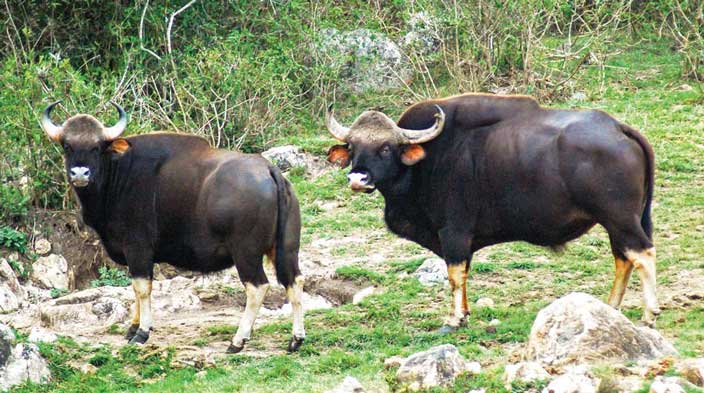
Bandipur has a handful of resorts and lodges including government-owned camps. The top of the heap is The Serai Bandipur. Bandipur is open throughout the year including the monsoon months. In addition to game drives you can go birdwatching; visit a local village, stop by a historic hilltop temple, cycle, trek or go clip-clop in a bullock cart.
For more information visit Karnataka Tourism:
www.karnatakatourism.org and www.theserai.in
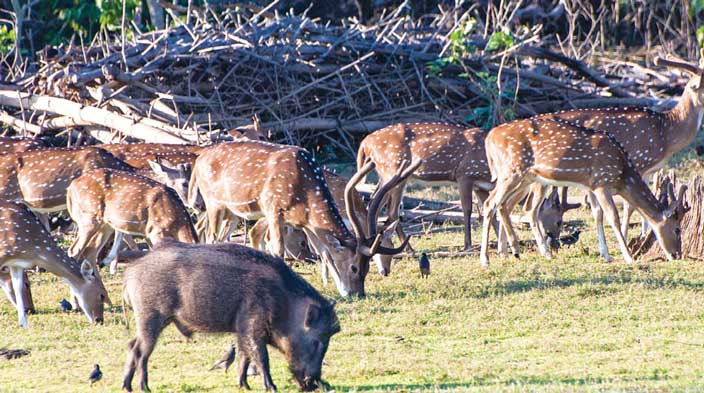
Nagarhole Tiger Reserve
Birds were well into their morning raga, welcoming the sun as it peered over the eastern horizon. Dew drops glistened on grass stems, leaves, wild flower petals and strands of silken spider webs. We stopped at a little shrine, snuggled under the aerial roots that drooped like a beard from the overhead branches of an ancient banyan tree. An offering of fresh flowers and a vermilion tikka smeared on a rock suggested that it was an active shrine. According to Sukanta Das, the naturalist-guide at The Serai Kabini, on the fringe of the Nagarahole Tiger Reserve in south Karnataka, folk lore has it that the twin sons of Ram – Luv and Kush – spent time here with their guru. However, the legend stutters and goes no further.
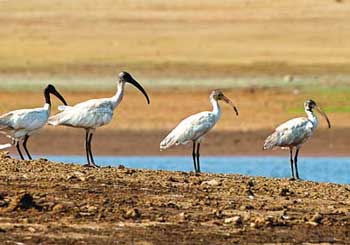
We moved on with our nature walk, nursing the hope that we might stumble upon the leopard that occasionally wanders into the shrub land that adjoins the national park. A butterfly fluttered over a cluster of wild flowers, taking sips of nectar as it skipped from bloom to bloom. Another settled on a pie of moist dung. “Animal droppings are rich in minerals and vitamins and from a butterfly’s point of view they are sit-down, fine dining options. Those that skip between flowers are bar hopping.” So beauty loves the crap! Das was a storehouse of delightful little nuggets of information. Further down the trail, we caught sight of a green rope draped over a wilted clump of tall grass. Litter in the forest? No, a green vine snake. Yes, that was what it was: a snake!
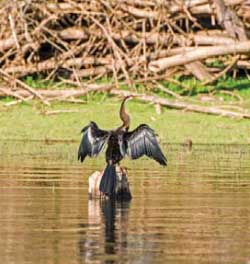
And we did not scamper away in terror! Instead we stood there, even edged a little closer, to admire the elegance and grace of the much maligned creature. And did we detect a hint of pleading in its slit eyes? A plea not to harm it as it stayed immobile, sunning itself? Greeny (our endearment for the graceful creature) must have been freezing through the night as dew drops sparkled like diamonds on its head and body.
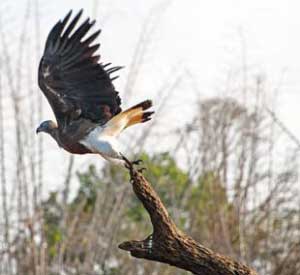
Greeny, we guess, was relieved when we moved on, little realizing that he was the prized sighting on our morning wildlife adventure. All too often, we miss the little gems that a safari offers in our obsession to see larger mammals like tigers, leopards and elephants, for instance. Indeed Nagarahole Tiger Reserve which basks on the banks of the Kabini River has the big guns, too. In fact, it is the stage for the largest congregation of Asiatic elephants in the world. For as waterholes inside the Nilgiri Biosphere which includes Bandipur, Mudumalai in Tamil Nadu and Wynaad in Kerala, dry up, these gentle giants converge on the river to feed on its grassy banks.
The pachyderm parade
We caught a glimpse of the first movement of this annual event as different herds, packing babies, their mothers, aunts and dominant matriarchs started to roll in and fill the landscape like actors gathering to take part in an epic movie. One herd crossed the road about 10 metres in front of our safari vehicle peacefully enough when suddenly the adolescent male bringing up the rear took umbrage at our presence and staged a mock charge. Feet stomping, trunk waving, ears flapping, it was an impressive show but it did not faze our driver-guide who held his ground. Later, he confessed that he had the vehicle in reverse and was ready to gun it away should the elephant decide to shift gears from mock to real.

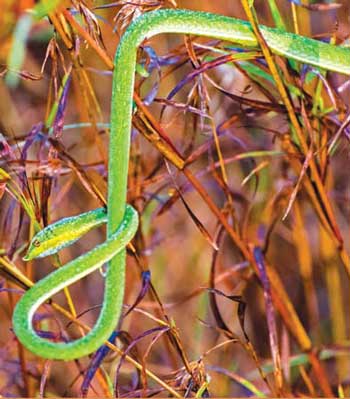
The best way to see the elephant parade is on a boat cruise safari which is one of the unique features of Nagarahole. The water based adventure let us see the wildlife park from a totally different perspective from a traditional game drive. A turtle resting on a piece of driftwood. A large log on a bank that started to move and betrayed the fact that it was actually a crocodile… a big one. On seeing us approach, the reptile paddled its bulky body, topped with cracked spikes (do female crocs find it attractive?), to the water’s edge and submerged itself like a stealth submarine.
Further down, a pair of fishing eagles shared a meal that was rudely interrupted by a crow that was looking for an opening to sneak in and snatch what was on their rustic dinner table. A kingfisher fell out of the sky and splashed into the water. Moments later, it was airborne again with a silvery fish in its beak. The bird then pulverised its twitching catch by giving it a few good whacks on the branch of a dead tree trunk, sticking out of the water, and swallowed it whole.
Yes, dead trees that reared out of the water like ghostly fingers were the remains of a forest that was flooded with the damming of the Kabini River, decades ago. Amazingly adaptable, birds have used these stumps to their advantage. Some use it as perches, other as fishing posts from where they drop down to pluck their catch from just under the surface of the water. A few build their nests up here as it keeps their eggs and brood safe from land-based predators. We cruised through one cluster of stumps which was studded with the nests of cormorants. The chicks in one nest were really pesky, pestering their mum for more food. Made us wonder what cormorant parents do when they have reached breaking point. Whack their chicks with their wings and say ‘enough is enough’? Or maybe birds are more patient with their kids than we humans are!
All along the banks of the waterway, the forest heaved with life. Elephants, the first movement of the great annual migration; wild boar; herrings, painted storks and egrets patrolling the water’s edge; peacock; monkeys; herds of spotted deer… Was it our imagination or did we spy the bushy tails of a pack of wild dogs planning an ambush on an unsuspecting fawn?
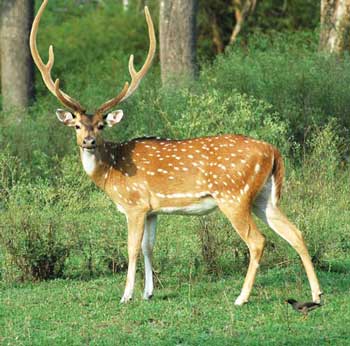

Later that afternoon, we got a bonus sighting of sleekbodied river otters as they swam past the motorboat that ferried us to the 800-year-old Bhiman Kolli Temple, dedicated to Lord Shiva. According to legend, Bhima of Mahabharata fame had rested here before crossing the river in a few strides to meet his Pandava brothers on the other side. We were certain that the gods would understand if we delayed paying our respect to them and spent a little time tracking the adventure of the hunting party. And sure enough, they made a kill: a large fish that the big daddy of the group carried to the shallows and chomped on as the rest of his family moved on.
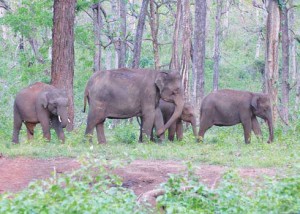
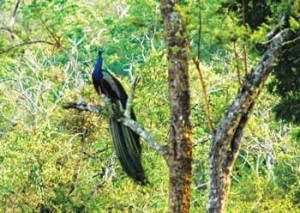
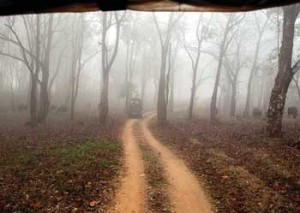
The evening safari was a more traditional game drive that threw up the expected: elephants, spotted deer, sambar, monkeys, a herd of white-socked gaur or Indian bison, woodpeckers drumming on the trunks of dead trees, giant wood spiders waiting patiently to snap up hapless insects snared in their sticky webs. We did not miss the tiger as it was a rewarding safari anyway!
Back at The Serai, Kabini, we checked into its spa and let the magic fingers of the therapist unravel the knotted muscles of our bodies. Later we nursed tall drinks at the Outpost Bar with its sweeping views of the river. A honeymooning couple whispered sweet nothings at a romantic table-for-two set up for them by the pool. A crescent yellow moon smiled down on the row of waterfront cottages and villas of stone and timber with sloping tiled roofs.
Later, as we snuggled in for the night, under warm blankets in an air-con room our thoughts reached out to Greeny. It would be another cold night for him. And while we felt sorry for him, we were happy he was not sharing our bed!
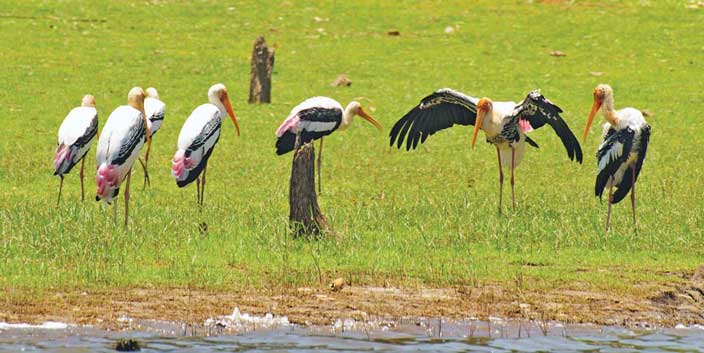
Fact File
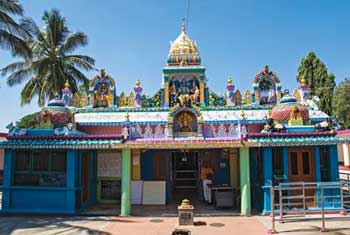
Kabini is the base to explore Nagarahole National Park. Bangalore (260) km is the closest airport. Mysore (76 km) is the closest railhead. This is a year-round destination and unlike many parks in North India, Nagarahole remains open even in the rains. In terms of accommodation, there are a number of options including The Serai Kabini, Orange County, Kabini, and the state-run Jungle Lodges and Resorts property which was once the hunting lodge of the former Maharaja of Mysore.
For more information visit Karnataka Tourism at:
www.karnatakatourism.org

